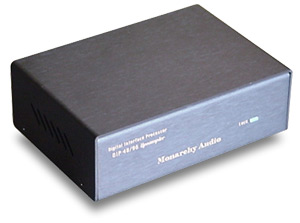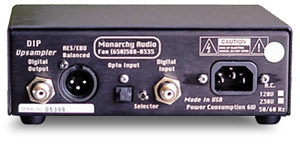![[SoundStage!]](../sslogo3.gif) Planet Hi-Fi Planet Hi-FiBack Issue Article |
|
March 2002 Our World What are we doing here? Every few months, as I fight 40 miles of morning traffic to get to work, I ask myself why I choose to work for a company headquartered in Stamford, Connecticut. Aren’t New Yorkers supposed to take the subway or at least the bus? I live two blocks from an express train stop and two steps from an express bus stop. Instead of a 30-minute commute, I’m pushing an hour and a half on some of the nation’s most neglected highways. How the heck am I supposed to catch Happy Hour at the Royalton? Inevitably, I remind myself that I have to sacrifice something important in order to obtain something better, namely greater overall personal satisfaction. Usually, money, career advancement, family, and personal fulfillment all factor into determining my overall satisfaction, and therefore help gauge whether a particular sacrifice is worth undertaking. Rolling to work in a tin can on wheels is a sacrifice worth taking. My friends call me Drone #072400 (the day I started working in Connecticut), but by the time I enter the office, my robotic trance falls away and I become energized and excited to be at work. I really like my job. The sacrifice is worth it. I feel the same way about coming on board with SoundStage!. Shutting down Planet Hi-Fi and letting go of all the hard work over six years was a very difficult decision -- but it was the right one. Dennis Hartwick and I had taken Planet Hi-Fi as far as it could have gone, as long as it could have lasted. We realized that it was the right time to stop as other interests and priorities began to infringe on our ability to publish a quality webzine with any sort of consistent frequency. Initially, I was relieved, as I no longer had the burden of meeting a deadline, both from a content point of view as a writer/editor and a coding point of view as a site developer (although I use that term loosely since I know very little HTML). I could finally take the long break from the webzine that I had planned to do for years. And admittedly, I was burned out on hi-fi, wanting never to switch a cable in or out again, eager to just listen to music for music’s sake. I even let my subscription to Stereophile lapse -- I know what you're thinking, "Blasphemy!" Well, I was pretty far-gone, shunning the audiophile community like a hi-fi hermit. Generous souls would toss the latest tweaks onto my doorstep, in the hopes of tempting me out of my hardened shell. Their lures failed miserably, as I used Final Labs Daruma 3-II isolators as trivets, Sennheiser HD600s as a replacement headset for my office phone, and the Caig Contact Cleaning Kit for my glasses. My situation was becoming hopeless. But one day, as my soup was coming to a boil and the carrots were lined up and ready, I heard the familiar "bing" from Microsoft Outlook that signals the arrival of new e-mail. I was one swing away from testing the Black Diamond Racing platform as a cutting board when I decided to walk over to my desk and open the message. It was from Doug Schneider, publisher of SoundStage!. It read, "Hi Gregory, Do you have a number I can contact you at? I have an idea I would like to discuss." Well, that intro clearly piqued my interest. I immediately replied and spoke to Doug the very next day regarding a proposal to have "Planet Hi-Fi" appear as a regular column within the pages of SoundStage!. It took me a couple of days to figure it out, but this was a great opportunity for Dennis and me. SoundStage! is a primo webzine, well managed, always expanding, and very much respected in the community by both readers and manufacturers. It does a lot of things right, many of which Planet Hi-Fi had difficulty pulling off. The more I considered the offer, the more excited I became about getting back into hi-fi, and especially writing for SoundStage!. Months of filthy hi-fi complacency fell away as I e-mailed back and forth with Dennis, Doug, and Marc Mickelson. We decided to launch our column April 1. For me, sacrificing the Planet Hi-Fi site for a more enjoyable existence at SoundStage! was an easy decision. I’ve got a tape recorder stuck to my back! So, I’m certain some of you are asking yourselves, "What’s the deal with this column?" The short answer to this question is simple. This column will be about our personal experiences with hi-fi. Dennis and I will alternate months and document anything and everything hi-fi in our lives, including brief equipment reviews, new music we've come across, local live performances, reader feedback, and interactions with fellow audiophiles, manufacturers and other reviewers. We live it, you read it. In many ways, this column will be autobiographical. Hopefully, you as readers will find it as entertaining as it is informative. ...Greg Kong Monarchy Audio DIP 48/96 Upsampler
Six months ago I reviewed the Monarchy Audio DIP 24/96, and I remain stunned by the little unit’s performance, especially considering its $249 price tag. In my mind, no digital front-end should be without one, even entry-level DVD players. In my system, the DIP 24/96 refined the audio signal to a degree that was non-debatable. Even my wife agreed that the improvement to the sound was obvious (although she continues to bust my chops about magical black boxes). You’d have to own a very impressive front-end to not benefit from the unit’s jitter suppression and signal conditioning. And the unit’s ability to accept a lower-quality digital input, such as plastic fiber optic, and output through a higher-bandwidth digital connection, is a huge benefit for audiophiles with MiniDisc players and gaming systems. So when Marc Mickelson sent over the new DIP 48/96 Upsampler for evaluation, I was anxious to hear what Monarchy Audio had developed for just $50 more than the DIP 24/96. Get rid of the lumps. I like my polenta smooth. I had the most delicious appetizer at a restaurant called Union Square Café. It wasn’t anything unusual, just plain polenta. But somehow, the chef managed to get the texture just the way I like it -- smooth, but not thin, substantial, but not too dense. The flavor was similar in strength and sweetness to other polenta I had tried, but getting the right texture made this version special. The DIP 48/96 Upsampler accomplishes the same feat with music as the highly regarded chef at Union Square Café accomplishes with food. But instead of wisking, boiling and cooling, the DIP 48/96 Upsampler de-jitters, boosts, re-clocks, dithers, and upsamples. Try that in the kitchen! Like the DIP 24/96, the DIP 48/96 Upsampler is housed inside a small black metal chassis with two digital inputs (TosLink and RCA) and two digital outputs (RCA and XLR). You can toggle between the two inputs using a switch located on the rear of the chassis and output to either one of the labeled outputs. In addition, there is a small green light on the front panel that indicates whether the unit has locked onto a signal. A standard female IEC receptacle on the rear accepts a detachable AC cord (provided).
According to the literature, the upsampling unit can and should be used in conjunction with the DIP 24/96 for maximum performance. Although both units attenuate jitter, apparently each unit has different jitter-attenuation characteristics that somehow compliment each other. He’s got lots of charm and grace. Slipping the DIP 48/96 Upsampler into the hi-fi chain produced a musical presentation that differed slightly from the sound produced when the DIP 24/96 was active. The music was fuller, more robust, especially in the lower region where string bass had more authority and weight. The top end was more refined with less edge and glare. I was finally able to listen to full-frontal string assaults at high volumes without cringing. There was also greater separation among instruments, especially noticeable within the midrange. From a broad perspective, the presentation with the DIP 48/96 Upsampler was more reserved, smoother, and appeared on a grander scale. In contrast, some may prefer the livelier, more precise sound through the DIP 24/96. And in some cases, I felt there was more information peering through with the DIP 24/96, as if the random noise (dither) was masking some of the details. Pop and rock recordings especially benefit from the increased pace and rhythm provided by the DIP 24/96. But poorly recorded songs deserve the DIP 48/96 Upsampler and the refinement that comes along with its upsampling abilities. I cued up some 24/96 DADs to see if there were any noticeable differences between the two units sans upsampling, and I was surprised to hear greater overall coherency through the DIP 48/96 Upsampler. The soundstage was significantly wider, and again, horns sounded smoother and female vocals more natural, as edginess and sibilance were reduced. The level of detail was unquestionable and differed from the DIP 24/96’s ability to pass this kind of information at the expense of listening fatigue. Are two heads better than one? What about using both units in series? Well, listening to both Red Book CDs and 24/96 DADs, with the DIP 48/96 Upsampler set to 48kHz and 96kHz, I had difficulty hearing an improvement using both DIP units that outweighed the benefit of having just the DIP 48/96 Upsampler in the equation. Considering the extra cost of adding the DIP 24/96 and a comparable digital cable to what you are currently using, I believe the cost/benefit analysis will show poor return on investment. I’d go with a lone DIP 48/96 Upsampler. Headline: Unemployment Checks Used to Purchase DIPs. Unless you have a superb front-end, or an existing jitter/upsampling box, I don’t see how anybody can afford not to invest in this device. Three hundred bucks gets you practical and useful features and audibly significant sonic benefits. In combination, they succeed in making the DIP 48/96 Upsampler, dollar for dollar, one of the most economical investments for your system. So next time you’re in town, make a reservation at Union Square Café. Ask for the DIP, extra smooth. It’s listed on the menu, right next to the polenta. Bon appétit! ...Greg Kong
|
|
|
|
![[SoundStage!]](../sslogo3.gif) All Contents All ContentsCopyright © 2002 SoundStage! All Rights Reserved |
 Pssst… The
Emperor’s got new clothes.
Pssst… The
Emperor’s got new clothes. Technically, the DIP 48/96 Upsampler and DIP
24/96 are similar in the following way: As the digital signal arrives from the transport,
both devices will boost the incoming signal from about 0.5V to around 5.0V, reduce the
number of timing errors, or jitter, and re-clock the signal. At this point, the DIP 48/96
Upsampler continues to enhance the datastream by adding dither to the mix, thereby
increasing the bit rate from 16 to 24 bits and upsampling the frequency from 44.1kHz to
either 48kHz or 96kHz. Users can choose between the two via a jumper on the main board
under the hood.
Technically, the DIP 48/96 Upsampler and DIP
24/96 are similar in the following way: As the digital signal arrives from the transport,
both devices will boost the incoming signal from about 0.5V to around 5.0V, reduce the
number of timing errors, or jitter, and re-clock the signal. At this point, the DIP 48/96
Upsampler continues to enhance the datastream by adding dither to the mix, thereby
increasing the bit rate from 16 to 24 bits and upsampling the frequency from 44.1kHz to
either 48kHz or 96kHz. Users can choose between the two via a jumper on the main board
under the hood.